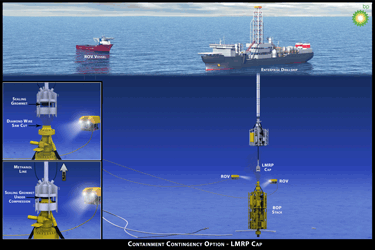BP Deepwater Horizon – Phase 3 Riser Removal and Capping of BOP
Posted: May 31st, 2010 by: h-2
Well, here’s two graphics that show the next step. You can get high resolution versions by clicking on the images. Source: BP riser cut/cap info page. (Update: see comments for updated progress on the shearing operation, which failed on the first attempt).
You can also watch the BP LMRP capping project video that was just released. Personally, that guy who presents makes me sort of ill to watch, but you can get a sense of the project, with liberal doses of Corporate spin to reduce the impression of disaster (note especially the image of the oil coming out of the BOP stack, it’s a light gray haze, instead of an angry black cloud, which is what it really looks like).
Step 2: lower the cover/LMRP cap onto the cleared BOP top:

And there you have it. Slice the main part of the drilling riser tube away from the BOP unit (blowout protector) with giant hydraulic clippers, then carefully slice the riser/drill pipe at the BOP with a diamond band saw.
That will in theory provide a reasonably flat surface to fit the device they will then lower down onto the top of the BOP.
The New York times has this piece today,
BP Tries Again to Divert Oil Leak With Dome
“This is a containment operation that is more straightforward,” Robert Dudley, BP’s managing director, told CNN on Sunday morning. He said containing most of the escaping oil until a relief well could be drilled was “not a bad outcome compared to where we are today.”
Mr. Dudley and other senior company officials have said they do not expect that the operation, even if it fails, will worsen the flow of oil significantly. BP officials said a week ago that they estimated that a 10 to 15 percent increase was possible until the cap is firmly in place.
But a technician working on the project expressed concerns that engineers cannot be sure how much more oil might escape if the operation fails.
“We’re all concerned about it,” said the technician, who spoke on condition of remaining unnamed because he is not authorized to speak publicly for the company. “We simply do not have the data about the internal geometry of the blowout preventer” to determine what volume of oil is being contained by the damaged blowout preventer and any damaged equipment or debris inside it.
During the previous attempt to install a containment dome, icy water rushed into the box and filled it with natural gas hydrates. Ice crystals formed from water and natural gas under the high pressure a mile down. There was no room left for escaping oil in the dome, which also became buoyant and rose to the surface.
This time, tubes will deliver heated sea water and antifreeze to the vessel. But the technician said that the formation of hydrates was still possible.

Quick update on this one:
Not confirmed yet, still catching up a bit on today’s progress.
In other words, as of that time the huge sheers failed to cut the riser pipe. This doesn’t really make the BP engineers look that great, I mean, they know what the pipe is, and what it takes to cut it, so one has to wonder a bit here about what’s going on. They tried a few different spots along the riser, I assume because maybe there were pipe joints that would be harder to sheer, but no joy, it just dented the riser pipe casing. Sigh. Well, they are trying, and it’s 5000 feet down, so I would imagine a lot of these things are just guesses to see if they will work, that’s how tech work is too, you never really know until you dig into the project what will work and what won’t, though you can have a good idea, but when it’s very complicated, which this project is at this point, you know less and less, and learn more and more.
Ah, a bit more:
And more, shear on the way back down:
And finally, a youtube video of the actual snip:
And finally, the diamond saw failed but they used the snippers to cut the top riser / drill string and are now ready to go ahead with the LMRP installation.
The diamond saw got stuck so they had to give up on getting a super clean cut.